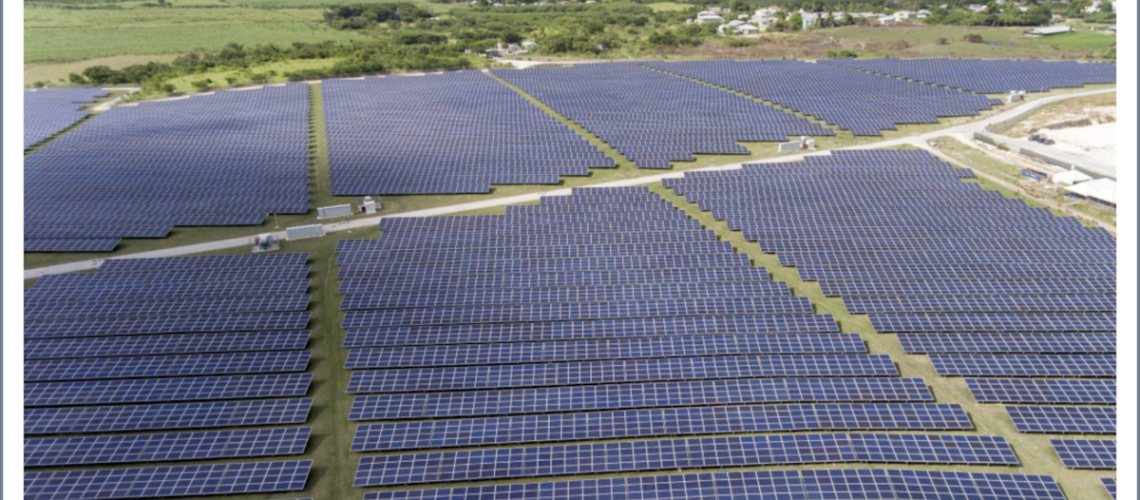The solar portfolio will be spread across 50 sites throughout the island-state, adding to Barbados’ 30 MW solar portfolio and pushing the country closer toward being powered by 100% renewables by 2030.
Jurchen Technology, a German-based manufacturer of racking and direct current (dc) cabling solar power plants, in partnership with Blue Circle Energy, a renewable energy developer based in Barbados, signed a Memorandum of Understanding (MOU) for the construction of a 60 MW portfolio of solar generation projects across Barbados’ 11 parishes.
The project consists of ground-mounted panels using Jurchen Technology’s PEG EW (PEG) racking solution. The solar plant manufacturer states that its PEG system constructed at an 8-degree tilt produces 225% more land yield than trackers and fixed tilt systems. This is due to the minimal spacing between modules stemming from their angular design. Moreover, racks will be situated at waist height, using an aerodynamic blueprint that the company says is engineered to withstand extreme wind from hurricanes.
The portfolio will include battery energy storage systems (BESS) either tethered to Barbados’ primary grid or spread across the project’s 50 sites, which will function as community solar gardens. Discussions around tariff rates for the portfolio’s BESS are still ongoing, and a decision needs to be reached before construction of the project begins. “We’re looking forward to a commercially viable tariff in early 2024,” said Cameron Steinman, president of Blue Circle Energy.
Barbados aims to be the first 100% renewable energy and carbon-neutral island-state by 2030, as outlined in its National Energy Policy document. The report includes ten visionary goals centered around creating a diverse, affordable and reliable portfolio of renewable energy options that promote the economic enfranchisement of Barbadians in various ways. Increasing the country’s energy independence is another approach to realizing this mission.
Not having to purchase international oil using foreign exchange reserves (primarily dollars) to power plants creates space to allocate those funds toward other meaningful infrastructure initiatives, Steinman said. According to the International Renewable Energy Agency, 95% of Barbados’ energy supply was imported in 2020. Oil provided the most significant energy supply at 92%, followed by renewables at 5% and gas at 3%. Bioenergy and solar were the largest renewable energy generators at 62% and 38%, respectively.
“Employing Jurchen Technology’s PEG EW racking solution to construct a 60 MW solar plant portfolio across Barbados represents a significant leap towards our renewable energy goals,” said Lisa Cummins, the minister of energy in Barbados.
The Barbados Light & Power Co. Ltd. states that its photovoltaic (PV) solar plant in St. Lucy, Barbados, adds 10 MW per day to the national grid. That is in addition to 25 MW of distributed, customer-owned solar rooftop generation. According to Sinalda, a global manufacturer of alternating current voltage systems, this figure increased to 30 MW of PV capacity in 2021.
While Barbados has a lower risk of hurricanes than other places in the Caribbean, climate change may alter that. The World Bank forecasts new rainfall patterns and more frequent and intense tropical cyclones in the region as global temperatures rise. According to Steinman, the spatial design of the solar-plus-storage plant can help increase grid resiliency in the face of unpredictable weather patterns. Otherwise known as single-point losses, residents will still have access to electricity if a storm damages a site.
The community solar garden portfolio will also allow about 300 sheep to graze across 30 sites. The agrivoltaic nature of the proposed solar plant adheres to an unwritten Barbados policy requiring the dual use of clean energy generation sites.
Steinman estimates the portfolio will hire between 20 and 50 people during its three-year construction period. After that, maintenance of the BESS will generate about 3 to 10 jobs on the island, some dedicated to security asset management.
Blue Circle Energy funds the development phase of the project, which includes permitting, licensing, early design, and scoping costs. Steinman said the company also pays landowners option payments to keep the land reserved while it sorts project delays. International hotelier Sol Ecolution will assume costs associated with paying for equipment, procuring contractors and final portfolio ownership over 20 years.



